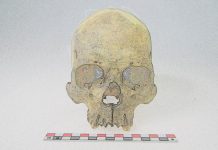
In the dense jungles of Guatemala, near the borders with Mexico and Belize, archaeologists have unearthed an ancient Maya tomb that dates back 1,700 years.
This significant find was made at the site of Chochkitam, revealing a treasure trove of artifacts and offering new insights into the Maya civilization during an era that remains largely mysterious.
Among the extraordinary items discovered within the tomb were a mosaic jade mask, rare mollusk shells from the spondylus oyster, and human femur bones with carved writings.
These carvings depict a man, believed to be a previously unknown king, holding a jade mask similar to the one found in the tomb.
This discovery is particularly exciting for researchers, as Francisco Estrada-Belli, the lead archaeologist from Tulane University who discovered the tomb, likened it to “winning the lottery” in terms of the wealth of information it provides.
The hieroglyphs on the artifacts are thought to identify the king’s father and grandfather, establishing a connection between this ruler and the powerful Maya states of Tikal and Teotihuacan.
This link is crucial for understanding the political and familial ties that influenced Maya rulership and its connections to other major centers of power in Mesoamerica.
The discovery of the tomb was somewhat fortuitous, coming to light only about 2 meters (6 feet) from where previous looting attempts had ceased.
Despite the potential threats of looting and natural decay, the tomb and its contents were remarkably well-preserved.
The use of lidar technology, which allows archaeologists to see through the dense jungle canopy and identify structures hidden below, played a pivotal role in locating this and other significant sites.
The tomb’s contents, including the 16 spondylus shells, not only highlight the luxury and wealth of the Maya elite but also underscore the significance of these items in royal and religious ceremonies.
Spondylus shells were highly valued for their beauty and rarity, often used in jewelry, currency, and offerings.
This find marks a century since the initial exploration of the Chochkitam ruins by Fran Blom of Tulane’s Middle American Research Institute (MARI).
Despite previous investigations, it wasn’t until Estrada-Belli’s team began their work in 2019 that such a significant discovery was made.
The team’s efforts underscore the importance of preserving and studying the rich and complex history of Indigenous America.
The next steps in the research will involve DNA testing on the bones found within the tomb, with the hope of uncovering further details about the individuals buried there and possibly revealing more secrets hidden within the abandoned pyramid.
This discovery not only adds a new chapter to the history of the Maya but also opens up new avenues for understanding the intricacies of their civilization, their connections with other cultures, and their practices of worship and rulership.
Copyright © 2024 Knowridge Science Report. All rights reserved.



